How Preventive & Predictive Maintenance Can Boost First-Time Fix Rates
Preventive and predictive maintenance can boost first-time fix rates (FTFR) by reducing the need for reactive repairs and emergency fixes.
Here’s how you choose the right CAFM
Investing in a CAFM system can be an expensive and high stakes undertaking, and the range of options on offer can seem complex and confusing.
With FM software it’s often hard to understand exactly what you’ll need - and practically impossible to try before you buy.
But make the wrong choice now and your selected software could end up unused and unloved by your team - a waste of time, money and procurement effort.
This guide will show you how to:
STEP 1: DEFINE your business and stakeholder needs
STEP 2: DELIVER the right CAFM to empower your FM team
STEP 3: SUPPORT your teams as they take your business to the next operational level
+
The last few years have accelerated the unstoppable disruption of the workplace. Digitisation, flexible working, tightening regulation, and now a global pandemic have all dramatically changed the way we operate and what we expect from our buildings.
Businesses are rapidly reconfiguring their working practices and offices to keep pace, while Facilities Managers are under intense pressure to respond to fast changing priorities.
At the same time, the C-Suite is demanding new levels of accountability and strategic insight from their FM function.
Spreadsheets and email aren’t cutting it as organisational tools anymore.
Facilities Managers are increasingly asking if CAFM systems are the answer.
.png)
What’s a CAFM system?
CAFM systems (Computer-Aided Facilities Management) are software solutions that help companies digitally manage various FM functions through a single platform. CAFM centralises all your FM operations and reporting.
They consolidate key FM data, driving insight, strategy and continual improvement. They can improve and automate reactive maintenance and PPM strategies, while extending digital control over contractor, compliance, property and asset management.
That’s a good question. FM software has been around for years, but only a fraction of businesses are actually using them - or using them to their full potential.
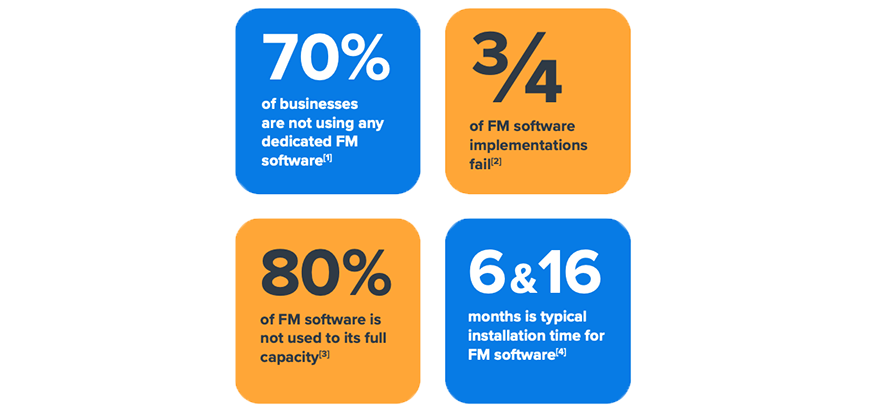
1. “Why Automation & Facilities Operations need to work together” - Future Proof conference 2019, Dubai
2. “What are the most common failures in CMMS implementation?”
3. https://www.sciencedirect.com/science/article/pii/S1877705816004641
4. https://www.sciencedirect.com/science/article/pii/S1877705816004641
There are literally 100s of competing FM software solutions on the market today, all promising to streamline FM processes and bring order to the chaos. It’s hard to choose between them and easy to make the wrong decision based on cost pressures or inflated promises of new functionality.
What’s more, too many FMs have been burnt by CAFM before - complicated, sprawling systems that cost tens of thousands of pounds and take months to install. They may have seen implementations that ended in failure and wasted money. They may have seen an FM team lose authority and budget on the back of a failed project.
Given all this maintaining the status quo may seem the easier option rather than face the cost and disruption of an unsuccessful installation.
But CAFM systems are changing. There are new systems coming on to the market which are focusing on mobile technology and user interfaces to make their systems quicker to learn and easier to use.
They’re helping companies win engagement in every part of their business and supply chain so they can get the best and most reliable data to optimise performance.
So, how do you choose a CAFM system that can rapidly deliver on your urgent FM priorities to secure early ROI?
How do you cut through that noise and understand what functionality you really need to make a difference to your bottom line.
How can you implement a system with minimum disruption, that the whole business can get behind and benefit from?
To make the right choice you need to find a partner that will help you:
Nadeem Ashraf, Head of Planning and EAM, Tesco
Want a copy to take away?
Learn how to select and implement a system with minimum disruption, that the whole business can get behind and benefit from. And make sure you only pay for what you need.
.png)
Step 1
Here’s the most important question. What are you trying to fix?
There is no CAFM silver bullet, no single ‘off the shelf’ answer to everyone’s FM challenge. This means you need to get specific.
What’s more, different organisations will be at different stages of the journey towards the transformation of their FM capabilities.
You need to think about where the gaps in your operations are right now. What do you need urgent help with? And what are the challenges you’ll need to tackle as you continue to grow?
Start by auditing your FM processes - identify gaps and weaknesses that are impacting your customer service and efficiencies, preventing strategic oversight and risking compliance.
Where are you on your road map and what are your roadblocks?
Some organisations are looking to take their first steps to replace paper systems or use digital tools to more effectively streamline operations.
Roadblocks to digital transformation:
Without a single facility management software solution, service delivery is fragmented and strategic oversight is limited.
The result:
Some businesses are further down the road, attempting to implement integrated help desk software and contractor management features to bring their processes under control.
Roadblocks to implementation:
Solutions that are over-complicated and hard to use can end up stalling FM transformation altogether.
The result:
Further down the line, teams want to automate FM business processes such as Planned Preventative Maintenance and compliance projects.
Roadblocks to automation:
More automation is needed to streamline operations, but existing CAFM solutions are proving difficult to configure and customise to meet specific needs.
The result:
Organisations need to track and optimise SLA performance and use data more proactively to drive operations.
Roadblocks to automation:At this stage organisations need more data on-demand to optimise performance and reporting
Roadblocks to analysis:
Data has the potential to reveal commercial and strategic opportunities, but it is frustratingly out of reach
The result:
Businesses need to start driving long term value from collected data. They need to proactively control costs, monitor budgets and make data driven decisions around asset management and capex projects.
Roadblocks to deployment:
Without the tools to see trends and monitor the performance of assets over time, long term maintenance and investment spending can’t be projected and controlled.
The result:
Solving problems like these requires a view from across your organisation.
Perhaps it is easier to think about the outcomes that will define success for teams in different parts of the business, to ensure you develop a more holistic solution.
When you are defining and specifying your software needs, listen to the people who will use the end product. This includes both internal and third party users. Without answering their specific challenges, adoption is likely to be restricted. It’ll be hard to take control and realise the required ROI.
Board of Directors:
Finance
Facilities & Estates
Helpdesk & Operations
Internal Maintenance
FMs looking to adopt facilities management software should carefully consider all their stakeholders’ needs. It may help to draw up a list of MOSCOWs (a list of things the software must, could, should and would solve for in an ideal world). This will help prioritise what you want to achieve from a purchase.
Requirements will differ between organisations. List them all, identify the gaps in your performance and size them up against what’s on offer.
Step 2
Now it’s time to get recommendations from your network and start researching potential partners so you can pull together a short list of suppliers.
CAFM systems can offer a range of functionality that solve specific business challenges for different stakeholders. They can present powerful, practical solutions for entrenched operational problems.
In your search for a supplier you should consider how system’s features and functionality address the specific gaps in capabilities you’ve identified.
You should be able to see how their benefits could be experienced and measured by your company as a whole - and how they could contribute to your wider business goals.
.png)
Here are some of the areas that many FM teams struggle with - and the kind of CAFM solutions that can help.
The problem:
Maintenance management is poorly coordinated and customers are poorly served - you are often stretched and struggling.
What to look for in a CAFM
Look for work order requests that work harder:
Look for seamless digital work order management:
The problem:
Contractors and engineers are managed in an ad-hoc way, you are not always getting value for money.
What to look for in a CAFM
You need tailored and personalised contractor portals that increase control
Look for SLA management tools to help FM optimise supplier performance
The problem:
Keeping control of compliance is a challenge - you need to stay on top of statutory obligations or risk possible H&S breaches, audit failures and fines.
What to look for in a CAFM
You need dedicated compliance tools:
Look for health and safety management features

The problem:
Costs are increasing and hard to control - revenue leaks are invisible. You need to proactively reduce the costs of reactive maintenance through smart workflow management that collects the crucial data points you require to actively demonstrate ROI.
You need more control over assets and contractors through a centralised tool.
What to look for in a CAFM
You need tools that actively help you control costs:
Look for tools to create and maintain a digital asset register:
The problem:
You are not efficient as an organisation. You can do better, but you need the right data.
What to look for in a CAFM
You need access to real-time, custom & visual dashboards and reports:
The discovery process so far has been about identifying urgent business needs and beginning to specify requirements. It should have helped you identify vendors with the offerings and reputation that seem like the‘right fit’ for you.
Fiona Happiness - Head of Facilities Management, UKTV
When you’re narrowing down your search for a CAFM partner there are four key areas to focus on which will ensure a supplier can deliver what you need:
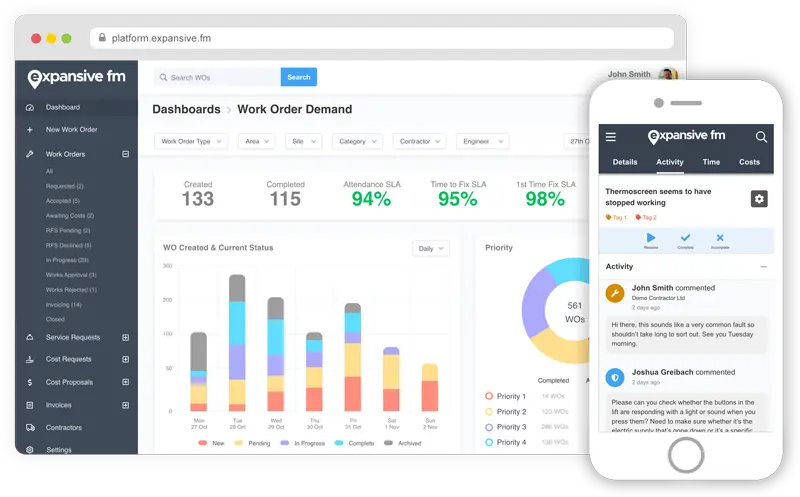
In an ideal system, different modules should feed into a single reporting system, powering day to day operations while making data available in real time to drive future decision making.
Connectivity and ecosystem:
how can a CAFM sit at the heart of your operations?
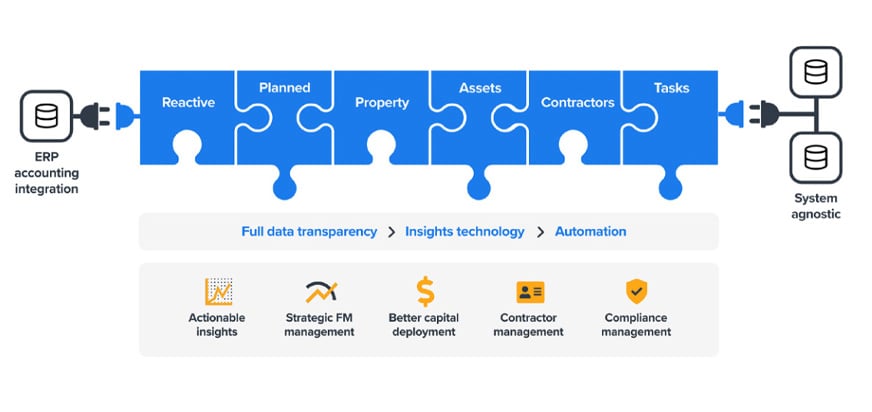
You should investigate exactly what software integrations are supported by your chosen system, the configuration options available (bespoke or open APIs) and any extra costs or time scales involved in their delivery.
For maximum scalability be sure your chosen CAFM has the capability to integrate into your ecosystem. For instance, integrating into accounting, purchase order or ERP systems are important in order to sync up financials. You may also be interested in integrating BMS (Building Management Systems) in order to auto-trigger work order requests when equipment fails or issues are recognised. In the long term, as sensor tech becomes more prevalent in the workplace, having the flexibility to quickly integrate with new systems will allow you to maintain a competitive advantage.
An absolute necessity for a Facilities Manager is to:
• Take control of your financials
• Monitor your spend
• Control your budget
Although it might not be your first priority, in time it will be vitally important that purchase order requests and invoices are imported into your accounting software and kept in sync. That way, you’ll be able to provide management information and reports that are aligned with your core accounting system.
.png)
Your chosen software should require minimal training to get up and running, or it risks going unused by the business as a whole. If it’s a pain to useand does not seem to actively add value, then teams will quickly find workarounds to shortcut the system.
The tools that any CAFM system offers should reflect the needs of the people using them.
If a contractor or engineer portal is not built to be used ‘on the go’ and in the field, it’s not fit for purpose.
Busy, ‘hands on’ FMs may need access to their work order management tools from their tablets and mobiles, as much as they do their laptops.
Making it mobile - what to look for in contractor and engineer tools
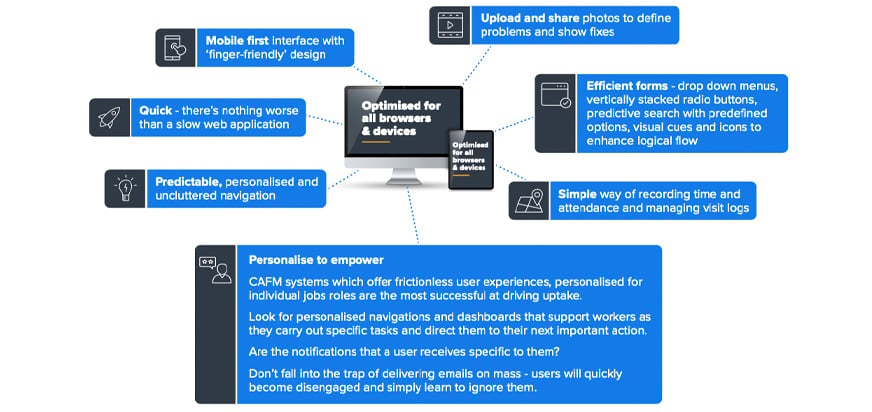
A mobile first navigation should ensure nothing is more than a few clicks away. It should deliver forms that collect more structured data upfront to capture required information first time, every time.
Native mobile functionality like photos, videos and geo-location can make it quicker and easier for users to upload required data as they make work order requests, compile asset registers and conduct H&S walkabouts.
This in turn will improve the level of user satisfaction, increasing uptake of the solution across the business.
The ability to configure settings by a non-IT specialist is a high priority for companies with limited tech resources available.
When you’re looking at a solution, consider how much of the set up is likely to be bespoke and in the backend.
Consider how long will it take to get the system up and running? At the more complex end of the FM market, months’ long installations are not uncommon, while some DIY solutions will simply charge you a license fee and let you get on with it.
Look for self serve features
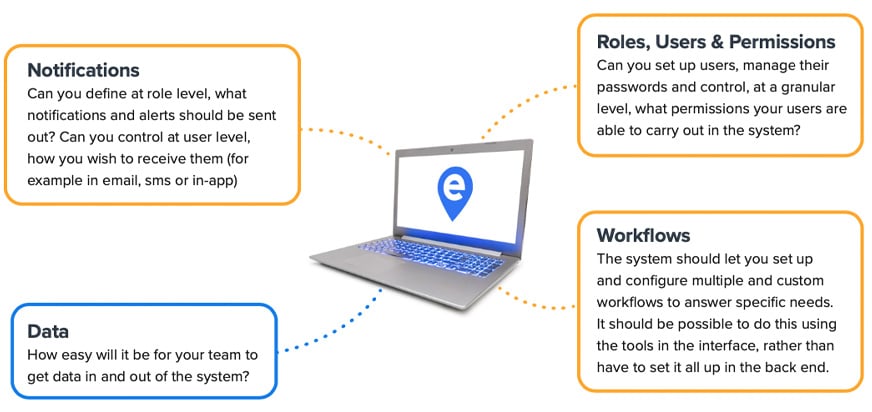
Data Portability:
Data management:
Data insights:
Data integrity:
Every Facilities Manager should have access to
There are 3 killer reporting dashboards you should be looking for in a CAFM, which will help you answer hundreds of strategic questions.
Designed well, these reports will give you the insight you need to help you manage your facilities operation at a strategic, data driven level:
Phil Singleton, Head of Corporate Real Estate, Swiss RE
You need a CAFM partner who can be flexible and responsive to your changing needs.
Many CAFM products are set up to be packed with advanced functionality from day one. This can be a shock to the system for some organisations who will need intensive training to start using all the features they’ve been given.
Being overwhelmed by complexity is a common reason for teams to abandon their CAFM and find shortcuts and workarounds to avoid engaging with it.
Only 6-15% of organisations are using their facility management system to their fullest capabilities.
Other teams are more than ready to ‘hit the ground running’. These teams want to quickly ramp up and use new functionality, but find a lack of support and flexibility from their software and vendors as they try to do so.
The approach you take to releasing a CAFM can have a dramatic effect on levels of uptake and success.
Some businesses prefer a ‘waterfall approach’ to release. This entails designing, then delivering an entire end to end FM solution in ‘one go’.
• Requires more training and preparation before go live
• Lengthy lead times can risk losing internal support
• Takes longer to see ROI from your investment
• Changing everything all at once can cause internal confusion
The alternative is to go live in stages, to realise rapid control of key FM functions and start seeing ROI as early as possible. This agile approach allows you to:
• Release in phases to selected teams/locations
• Launch with a basic set of features
• Add new functionality in sprints
• Optimise each release to improve performance as you go along.
The advantage of working this way is that you can use data and insight acquired in each stage of a phased roll out to direct your next steps and optimise your strategy.
Seeing real time improvement of KPIs emerging in the stats on the basis of actions taken, can help justify further investment in ‘next level’ features.

.jpg?width=872&name=Agile%20Process%20(example).jpg)
• Be sure that your chosen CAFM partner will work with you to map your needs and design a solution that fits your unique requirements.
• Focus on integration, configuration and usability for maximum impact
• It shouldn’t take months (or even weeks) to set up the system and train workers how to use it.
• Choose a system that can become a ‘single source of truth’ for your whole business - supporting day to day operations and your strategic overview
Step 3
How to choose a partner, not a supplier
If you do not have any support technically in-house, then it’ll be important to choose a package with strong configuration and technical support included.
What happens if there’s a problem? Do you need to raise a ticket online, or do you have a dedicated account manager at the end of the phone?
Are you on your own until it comes to your annual renewal? Will you get the personal attention you need to optimise and strategise for more long term benefits?
And then, there’s the costs.
How much does a CAFM system cost?
This is the really big question and you should have a clear view of what’s included in the cost before you commit. Many CAFM vendors will offer different tiers of service depending on the size of your facilities operation, the features and support you require.
Initial configuration costs may vary from £100s to £10,000s
Complex installations can take months to complete
But they may offer little in the way of flexibility for your individual needs
Typically includes:
Other considerations:
Basic entry level packages start at £100 per month but can rise to £1000s
Costs can quickly increase if you add new team members, sites or new suppliers
Typically includes:
Other considerations:
Free account management support may be restricted to a number of hours per month
‘DIY platforms’ may offer little or no AM support
Typically includes:
Extra support beyond initial configuration and standard AM is likely to cost you
Check a supplier can offer help with bespoke configuration tasks
Typically includes:
Costs are often advertised as a monthly or annual license fee, which usually include a certain number of ‘seats’. But most operators will charge a set up cost to configure the system before you can start using it.
After that, as with most SaaS, hidden charges can often make reasonable sounding deals escalate quickly in price. Understanding the cost structure up front and what level of support ‘comes as standard’ will prevent any misunderstandings.
We recommend you choose a partner who can flex with you during times of need. In order to realise the true ROI of the platform, reap the full benefit and keep up momentum - choose a partner with not only a great product, but people you can work with and act as an extension to your team.
Above all, you need to know how the partner you choose will cluster around you to solve the challenges that you are facing now - and those you’ll need to address in the future.
Some companies may want to choose a more heavy weight supplier with a mature product because it feels like you’re buying the ‘best in breed’, or, at least, a stable and tested solution.
However, there is a danger that these vendors won’t be able to offer you the flexibility you need as you address your specific challenges - and you’ll simply ‘get lost’ among their client list.
If you’re looking to work closely with a supplier to optimise your approach, you may wish to select an agile partner who can be more consultative and collaborative as your needs evolve.
Whichever way you go, you should be looking for a reliable and experienced guide to take you on your journey.
• Can you see evidence that the vendor is committed to a programme of continuous improvement and innovation?
• Will advances in AI and its potential for delivering better, more predictive FM be in the mix?
• Do you have the confidence that as your demands increase, the system can change and scale up with you? Will your partner take into account your feedback and feature requests?
A brief internet search will tell you there are over 200 FM software solutions of all shapes and sizes being sold on the market today.
What makes one vendor more credible than another?
Look at the composition of the team. Has the solution been created by FM professionals?
Do they have specific experience of working in the FM world as well as excellent software development credentials?
How many years’ experience does the company have in the business? How many customers do they have and what’s their retention rate?
What’s their story and their beliefs about the market that makes them unique and drives their development road map.
It’s important to see how their software is currently being used in the real world. Who are the existing customers and what sectors are they in?
Are they dealing with the same challenges as you and achieving proven success with the software? What are the lessons of their implementation that you can learn from them?
Testimonials should be available. If you can, try and arrange to actually talk to their clients about their experience of working with them.

Your CAFM will be a success if it gives you the operational controls you need, while empowering your team with the data and insight that can help you deliver on wider business objectives.
For this, it needs to be highly usable and sit at the heart of your organisation as a ‘single source of truth’.
Visibility & Control
by consolidating all data, comms and presenting a birds eye view of the entire operation
Improved Service
by automating processes, being collaborative, proactive and performance managing the supply chain
Reduced Risk
by dynamically scheduling compliance tasks, automating communication and receiving alerts of any breached services
More Strategic
by adopting a data-driven strategy that reduces spend and supports the overall business objectives
Reaching this level of usage and support in an organisation is the way in which a CAFM can shift from being simply an operational tool to a business insight platform in its own right.
But to get to this stage, you will need to overcome the organisational hurdles that can hamper success.
When results are slow to emerge it can cause interest and support to vanish across an organisation.
The right vendor should be there at every stage to help you analyse and use the data to drive decision making about optimisation and where to focus resource next.
In these early stages of implementation, it’s vital that you’ve got their support to keep tweaking and improving your approach, to improve results.
The CAFM vendor you choose should be an active source of help to keep your team on track and focused on meeting the overall goals of the project.
Nadeem Ashraf - Tesco
1. Set your goals
2. Understand each stakeholder’s needs
3. Pick a partner with relevant and strong credentials
4. Be clear on the features required and what problems they solve
5. Pick something modern, flexible, that can integrate
6. Understand what levels of support you’ll need and what you’ll get
7. Choose a partner and not ‘a supplier’
Want a copy to take away?
Learn how to select and implement a system with minimum disruption, that the whole business can get behind and benefit from. And make sure you only pay for what you need.
.png)
Preventive and predictive maintenance can boost first-time fix rates (FTFR) by reducing the need for reactive repairs and emergency fixes.
The manual quoting process is draining your sales team's energy and your bottom line. Every hour spent on spreadsheets is an hour not spent closing deals. Every pricing error is a potential client ...
Facilities Managers are often under pressure to reduce FM costs in their organisations. This can be achieved by focusing on a few key areas, such as implementing predictive maintenance, using smart ...
What's new at Expansive this month? This month, we've focussed on the ability to group contractors using tags as well as our new AI invoice submission tool.
What Is Facility Management? Facility Management, or FM, is the responsibility of keeping buildings and workplaces running smoothly. Whether it's an office, hospital, school, or manufacturing plant, ...
Whether you're running a single office or multiple sites across the country, the complexity of facility management demands smart solutions.